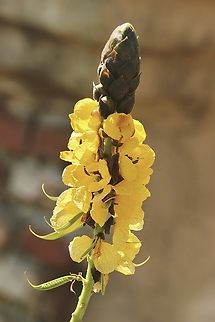
Appearance
African senna is a hairy, aromatic shrub usually growing up to about five meters tall but known to reach nine meters in optimal growing conditions. The leaves of the plant are up to half a meter long and are made up of many pairs of elongated oval leaflets each up to 6.5 centimeters long.The African senna plant has a strong, distinct scent that has been variously described as being reminiscent of mice, wet dog, peanut butter, and burnt popcorn.
The plant flowers plentifully in racemes of bright yellow flowers, with some flowers also occurring in leaf axils. The flower raceme has open flowers on the lower part with unopened buds at the tip covered in stark brownish green or black bracts. The flower has five concave petals each 1.5 to nearly 3 centimeters long. The flower has ten stamens, usually seven fertile ones and three sterile staminodes. Some of the stamens have large anthers measuring a centimeter long.
The fruits of the African senna plant are flat brown legume pods up to 12 centimeters long, each containing as many as 16 bean-like seeds that are themselves up to a centimeter long each.
The plant is poisonous.
Uses
In Kenya, some cultures, particularly Kalenjins, use the plant to prepare a special type of sour milk which is used mainly during festivities. A sizeable tree is cut and its branches pruned. The bark is mostly removed, then dried. Once the bark is dry, and the specially made calabash gourd, or Sotet, has been cleaned and dried, the senna bark is put in a fire, and removed when charred. The process emits fragrant smoke. The charred bark is used to coat the inside of the gourd, which is subsequently used for the storage of fermented or fresh milk.The leaves of this plant can be squeezed, and the extract mixed with water to create a bath that helps cure skin infections.
References:
Some text fragments are auto parsed from Wikipedia.